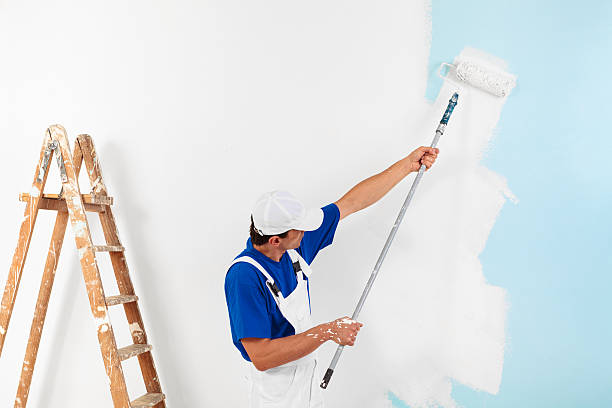Exploring the Different Kinds of Paint: A Guide for Every Task
Checking out the different sorts of paint is crucial for achieving the desired outcome in any type of task. From water-based alternatives that use benefit to oil-based paints known for their resilience, each choice has its qualities. Specialty paints can include distinct textures or finishes, while environmentally friendly choices deal with those seeking sustainability. Understanding these differences can greatly impact the success of a paint endeavor. What aspects should one consider when making the ideal option?
Comprehending Paint Kinds: Oil-Based vs. water-based
Paint kinds can considerably impact a job's outcome, and recognizing the differences in between water-based and oil-based paints is necessary for informed decision-making. Water-based paints, usually described as latex paints, are made up of water as the primary solvent. They dry quickly, discharge fewer unstable natural compounds (VOCs), and are easy to clean up with soap and water. This makes them a preferred option for indoor applications and atmospheres where air top quality is a problem.
On the other hand, oil-based paints use natural solvents, providing a sturdy, glossy finish perfect for surfaces subjected to tear and use, such as trim and cabinets. They take longer to dry, require mineral spirits for cleaning, and have a more powerful odor. paint store corpus christi tx. Choosing in between these two kinds relies on the specific requirements of the job, thinking about elements such as preferred surface, application atmosphere, and convenience of maintenance. Each type has distinct benefits and restrictions, directing the option process
The Complete Matters: Picking Between Matte, Satin, and Gloss
When selecting a paint surface, the selection in between matte and shiny options considerably influences both looks and functionality. Matte coatings provide a subtle, non-reflective appearance that can hide surface area imperfections, while glossy finishes provide longevity and simplicity of cleaning. Understanding the advantages and considerations of each can aid in making an educated decision for any type of paint project.
Matte Complete Benefits
Although numerous house owners question the values of various surfaces, matte paint uses distinct benefits that make it a prominent option for both exterior and interior applications. Among the primary benefits of matte surface is its capacity to conceal surface area blemishes, creating a smoother appearance on wall surfaces. This high quality is especially helpful in older homes or rooms with unequal surfaces. In addition, matte paint soaks up light instead than mirroring it, which can boost the visual of a room by giving a much more advanced and muted look. Matte finishes are frequently simpler to touch up than glossier choices, as they can blend a lot more perfectly when applied over existing paint. In general, matte paint is an exceptional option for those looking for a refined and elegant surface.
Glossy End Up Considerations
A shiny surface can significantly change the assumption of a room, providing a sleek and reflective quality that enhances both shade vibrancy and light within a room. This coating is typically preferred for high-traffic locations and surface areas like bathroom and kitchens, where durability and convenience of cleaning are essential. Nonetheless, its reflective nature can highlight flaws on wall surfaces, making correct surface prep work crucial. Shiny paints also have a tendency to show finger prints and smudges quicker, necessitating regular upkeep. Additionally, illumination plays a substantial function; in brilliant atmospheres, a glossy coating may produce glow, affecting the total aesthetic. As a result, mindful factor to consider of the certain application and environment is very important when selecting a shiny finish for any kind of job.
Specialty Paints: When to Make Use Of Textured or Chalk Paint
Specialized paints, such as distinctive and chalk paint, deal distinct visual and practical advantages that can boost numerous surface areas. Distinctive paint is perfect for creating depth and measurement on walls, concealing flaws while adding a three-dimensional feel. It is particularly useful in high-traffic areas where resilience and aesthetic passion are crucial.

Both kinds of specialty paints can change rooms, but choosing the best one relies on the desired effect and surface area demands. Textured paint might match bigger locations, while chalk paint can revitalize smaller sized items, showcasing creative thinking and personal style in any type of task.
Exterior Paints: Protecting Your Surfaces From the Components
Outdoor paints are crucial for protecting surfaces against numerous weather. Understanding their climate resistance attributes, correct surface area preparation needs, and reliable application techniques can considerably boost toughness and performance. This section will detail key factors to consider for picking and making use of outside paints successfully.
Weather Resistance Features
Weather resistance is a necessary feature of outside paints, as it identifies exactly how well surface areas can withstand the extreme components of nature. High-grade outside paints are developed to stand up to damages from UV rays, dampness, and temperature level fluctuations. UV resistance assurances shades remain lively in time, preventing fading and staining. Dampness resistance safeguards versus mold and mildew and mold, which can endanger the honesty of surface areas. Additionally, paints with outstanding temperature resistance can acquire and increase without fracturing, preserving their protective qualities. When picking outside paints, it Extra resources is essential to take right into account these climate resistance features, as they add to the durability and resilience of coloured surfaces, making certain they continue to be cosmetically pleasing and functional despite exposure to the aspects.
Surface Area Preparation Demands
Appropriate surface preparation is an essential action in achieving the finest results with exterior paints. To ensure optimal adhesion and durability, surfaces have to be extensively cleansed, removing mildew, find out dust, and oil. This can be completed using a pressure washer or a scrub brush with a suitable cleaning option. Once cleaned up, surface areas need to be examined for any kind of peeling or flaking paint, which should be scuffed away to produce a smooth foundation. Repairing any type of holes or fractures is also essential, as these can allow wetness infiltration. Additionally, sanding rough areas advertises much better paint adhesion. Finally, applying a guide suited for outside use can improve the paint's efficiency, ensuring a lasting finish that withstands the components. Correct preparation is vital to a successful exterior paint project.
Application Methods Tips
While using outdoor paints, it is essential to make use of reliable methods that ensure surfaces are well-protected against the elements. First, pick the best day for paint; reduced humidity and moderate temperatures improve adhesion and drying out. Prepping the surface completely-- cleaning, sanding, and priming-- guarantees better paint adhesion and durability. Using high-quality brushes or rollers can provide a smoother coating, while spray paint may cover large areas successfully. Applying paint in slim, also layers protects against drips and runs. It is suggested to follow producer instructions pertaining to drying times between layers. Finally, verify proper ventilation throughout application to facilitate drying out and minimize exposure to fumes. These strategies greatly boost the long life and efficiency of outdoor paint.
Eco-Friendly Options: Low-VOC and Zero-VOC Paints
As customers become progressively aware of the ecological influence of their selections, low-VOC and zero-VOC paints have become prominent alternatives. These paints are formulated to include less volatile natural substances (VOCs), which are chemicals that can evaporate right into the air and add to air contamination and illness. Low-VOC paints generally have a restricted quantity of VOCs, while zero-VOC paints have negligible degrees, making them more secure for both exterior and indoor use.
The benefits of making use of low-VOC and zero-VOC paints extend beyond environmental considerations; they likewise enhance interior air quality, minimizing the risk of respiratory system issues and allergies. Many makers currently offer a range of colors and coatings in environmentally friendly options, making it simpler for consumers to find appropriate products for their jobs. By going with these paints, individuals can learn the facts here now contribute to a much healthier atmosphere while still attaining the visual they prefer in their rooms.
Tools and Methods for a Flawless Application
Attaining a remarkable paint application requires the right tools and strategies, which can considerably boost the final outcome. Picking the ideal brush or roller is vital; brushes function well for sides and detailed areas, while rollers cover larger surface areas effectively. Making use of high-quality materials assures much better paint circulation and decreases streaks. For ideal outcomes, surface preparation is necessary. This consists of cleaning, sanding, and priming surfaces to promote bond.
Technique also plays a considerable function. The "W" approach with a roller assists to uniformly disperse paint, while long, smooth strokes with a brush protect against visible lines. Operating in sections enables much better control and mixing. Additionally, using slim layers is more suitable to thick layers, lowering the danger of drips and irregular textures. Maintaining a damp side throughout application helps achieve smooth adjustments in between areas. By integrating these tools and methods, one can achieve a professional and refined coating.
Tips for Preserving and Caring for Your Painted Surfaces
Appropriate upkeep and treatment of coloured surfaces can substantially expand their lifespan and preserve their look. Regular cleaning is essential; making use of a soft fabric or sponge with moderate soap and water can get rid of dirt and dust without harming the paint. It is suggested to avoid abrasive cleaners or scrubbing pads, as these can damage the surface area. Furthermore, applying a fresh coat of paint every couple of years can rejuvenate the color and protect against wear.
For outside surface areas, examining for indications of peeling off or fading routinely is necessary. Quickly attending to any concerns prevents additional damage. In areas vulnerable to dampness, such as bathrooms, using mold-resistant paint and ensuring proper air flow can aid preserve the stability of the paint. Lastly, using safety surfaces can protect against UV rays and discolorations, guaranteeing that repainted surfaces continue to be enticing and dynamic for years ahead, ultimately enhancing the general visual of the space.
Frequently Asked Inquiries
Can I Mix Different Kind Of Paint Together?
Mixing various sorts of paint is typically not advised, as it can bring about issues like poor adhesion, inconsistent structure, or unforeseen chemical responses. It's finest to make use of compatible paints for perfect outcomes and durability.

Exactly how Do I Properly Shop Extra Paint?
To properly save leftover paint, secure the container firmly, label it with the day and shade, and keep it in a cool, completely dry place far from direct sunlight and severe temperatures for suitable preservation.
What Is the most effective Method to Get Rid Of Unused Paint?
The most effective method to take care of extra paint is to examine regional regulations, as many areas have actually marked dangerous waste facilities. Alternatively, take into consideration donating useful paint to community companies or colleges for their projects.
Just How Can I Tell if Paint Is Still Excellent to Utilize?
To figure out if paint is still good, analyze its consistency, shade, and odor. If it appears separated, has an unpleasant odor, or shows significant changes in appearance, it's likely no longer functional.
Are There Age Restrictions for Getting Paint Products?
In many regions, there are no particular age restrictions for purchasing paint items. Some shops may require customers to be at the very least 18 years old, particularly for products having solvents or hazardous products.
Paint kinds can significantly affect a job's end result, and recognizing the differences between oil-based and water-based paints is vital for educated decision-making. Water-based paints, commonly referred to as latex paints, are composed of water as the key solvent. In contrast, oil-based paints utilize organic solvents, offering a sturdy, glossy finish ideal for surfaces exposed to put on and tear, such as trim and cabinets. Specialized paints, such as distinctive and chalk paint, offer unique aesthetic and practical advantages that can improve numerous surfaces. In locations prone to dampness, such as restrooms, making use of mold-resistant paint and guaranteeing proper air flow can assist maintain the integrity of the paint.